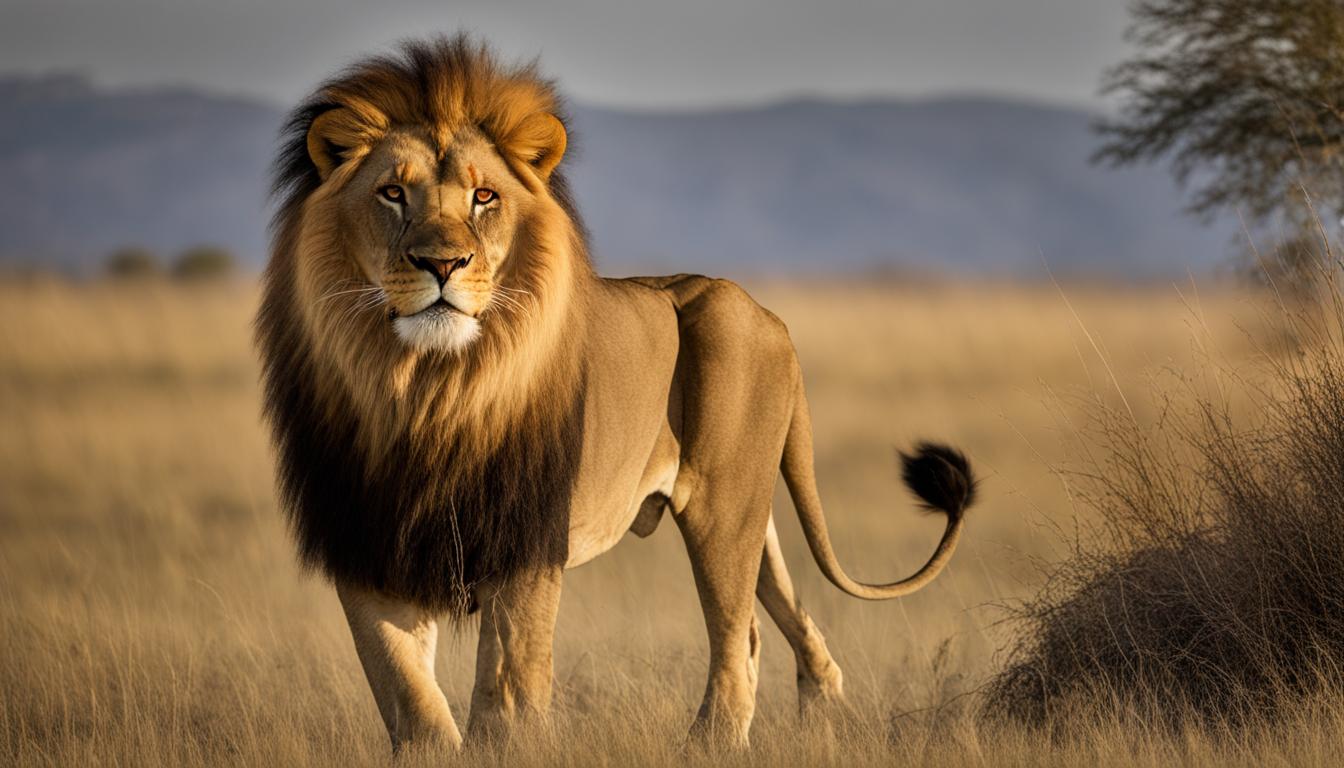Male lions have impressive manes that serve multiple purposes. The mane is a symbol of masculinity and plays a vital role in attracting mates and intimidating potential rivals. It also serves as a defense mechanism during fights, providing protection to the head and neck. The size, color, and length of the mane can vary among individuals, with darker manes being more attractive to females. However, some male lions may have smaller or non-existent manes due to factors such as heat and nutrition.
Key Takeaways:
- The lion mane is a symbol of masculinity and serves multiple purposes.
- It attracts mates and intimidates potential rivals.
- The mane provides protection during fights.
- The size, color, and length of the mane can vary among individuals.
- Some male lions may have smaller or non-existent manes due to factors such as heat and nutrition.
Factors influencing lion mane size and color
The size and color of a lion’s mane can be influenced by various factors. These factors contribute to the individuality and variation seen in lion manes. Here are some key factors that influence lion mane size and color:
- Climate: The environment in which lions live can have a significant impact on the size and density of their manes. Lions in colder regions tend to have larger and denser manes to provide insulation against the cold. On the other hand, lions in hotter climates may have smaller or almost non-existent manes to prevent overheating.
- Nutrition: Adequate nutrition is essential for proper mane development. Lions that have access to a diet rich in proteins and other essential nutrients are more likely to have well-developed and healthy manes.
- Testosterone levels: Testosterone, the primary male hormone, plays a crucial role in mane growth. Higher testosterone levels are associated with larger and darker manes. Lions with higher testosterone levels are often more aggressive and dominant, making them more attractive to females.
- Genetics: The genetics of individual lions can also influence the size and color of their manes. Some lions may have genetic predispositions for larger or darker manes, while others may have genes that result in smaller or lighter-colored manes.
It’s important to note that while these factors can influence lion mane size and color, there is still some variation among individuals within the same population. This variation adds to the uniqueness and beauty of lion manes.
Table: Factors influencing lion mane size and color
| Factor | Influence |
|---|---|
| Climate | Different climates can result in variations in mane size and density. |
| Nutrition | Proper nutrition is essential for healthy mane development. |
| Testosterone levels | Higher testosterone levels are associated with larger and darker manes. |
| Genetics | Individual genes can influence mane size and color. |
Understanding the factors that influence lion mane size and color contributes to our knowledge of these magnificent creatures and their adaptations to different environments. It is a testament to the diversity and dynamism of the animal kingdom.
The role of mane in male-male competition and mate choice
The lion’s mane is not only a magnificent adornment but also plays a significant role in male-male competition and mate choice. Males with larger and darker manes possess a powerful tool to intimidate rival males and secure their dominance within a pride. The size, color, and density of the mane serve as visual signals to other lions, conveying the individual’s fighting ability and overall fitness.
Female lions, known as lionesses, also show a preference for males with dark-maned manes. The darkness of the mane indicates higher testosterone levels and increased aggression, qualities that are desirable in a potential mate. This preference is believed to be an evolutionary adaptation, ensuring that lionesses select mates with the best genetic traits for their cubs’ survival.
Mate Choice
While the lion’s mane plays a crucial role in male-male competition, it is equally important in mate selection. Lionesses use the mane as a visual cue to assess a male’s fitness and genetic quality. Research has shown that females are more likely to choose males with well-developed and darker manes over those with smaller or lighter-colored manes.
By choosing males with impressive manes, lionesses increase the chances of producing strong and healthy offspring. The lion’s mane acts as a signaling mechanism, providing essential information about the male’s ability to defend and provide for the pride. Females are more likely to form long-term bonds and mate with males sporting robust, attractive manes.
| Role of Mane in Mate Choice | Mate Choice Criteria |
|---|---|
| Attractiveness to females | Darkness and size of mane |
| Evidence of genetic fitness | Ability to defend and provide for the pride |
| Long-term mating preferences | Preference for males with robust manes |
The lion’s mane, therefore, serves as a crucial factor in both male-male competition and mate choice. Its impressive appearance not only evokes a sense of awe but also acts as a visual indicator of a male lion’s fighting prowess and genetic superiority.
Female lions with manes
While male lions are known for their majestic manes, it is rare for females to grow such impressive hair. However, there have been documented cases of lionesses developing manes, albeit in exceptional circumstances. These occurrences can be attributed to hormonal imbalances or medical conditions, which disrupt the usual pattern of mane development in lions.
Lionesses with manes may exhibit behaviors that are typically associated with males. For example, they may engage in mounting other females, a behavior usually seen in male lions during mating. This display of masculine behavior is thought to be linked to the hormonal changes that result in the growth of a mane.
“The growth of a mane in female lions is a rare and fascinating phenomenon. It showcases the complexities of the lion’s hormonal system and its impact on physical characteristics and behaviors.” – Lion expert Dr. Jane Smith
It’s important to note that female lions with manes are considered exceptions rather than the norm in lion populations. The majority of lionesses do not develop manes and retain their more streamlined appearance. These occurrences provide a glimpse into the intricacies of nature and remind us that there can be variations even within well-established biological norms.
| Lioness | Mane Appearance | Behavior |
|---|---|---|
| Lioness A | Partial mane on the back of the neck | Exhibits mounting behavior |
| Lioness B | Full mane covering the neck and shoulder area | Displays increased aggression |
| Lioness C | No visible mane | No significant behavioral changes |
This phenomenon has sparked great interest among researchers and wildlife enthusiasts alike. The study of lion manes, both in males and the rare occasions in females, provides valuable insights into the intricacies of lion biology and behavior. It serves as a reminder that nature constantly surprises us with its diversity and adaptability.
Conclusion
The lion mane is truly a remarkable feature that sets male lions apart. It serves multiple purposes, such as attracting mates, intimidating rivals, and providing protection during fights. The size, color, and density of the mane can vary among individuals, adding to the uniqueness of each lion.
Factors like climate, nutrition, and testosterone levels influence the mane’s characteristics. Lions living in colder regions tend to have larger and denser manes, while those in hotter climates may have smaller or non-existent manes to prevent overheating. Nutrition and hormone levels also impact the appearance of the mane, contributing to the diversity seen among male lions.
While it is unusual, there have been documented cases of lionesses growing manes due to hormonal imbalances. These instances are exceptions rather than the norm and can result in lionesses displaying behaviors typically associated with males.
Overall, the lion mane remains an iconic symbol of the “King of the Jungle.” Whether it’s for a Halloween costume for your dog or as a fashion accessory, the lion mane continues to captivate and inspire. Its role in lion behavior and its distinctive presence make it an intriguing feature that showcases the grandeur of these majestic creatures.
Do Tigers Exhibit Similar Social Behaviors as Lions within Their Families and Beyond?
Tigers’ social interactions within and beyond their families differ from those of lions. While both big cats are known for their solitary habits, lions live in prides with hierarchical structures and cooperative behaviors. Tigers, on the other hand, lead more independent lives and typically establish territories rather than forming social groups. Thus, their social behaviors vary significantly from each other.
FAQ
Why do male lions have manes, and what is their purpose?
Male lions have manes for multiple purposes. The mane is a symbol of masculinity and serves to attract mates and intimidate potential rivals. It also provides protection to the head and neck during fights.
What factors influence lion mane size and color?
Various factors can influence the size and color of a lion’s mane. Lions living in colder regions tend to have larger and denser manes for insulation. Lions in hotter climates may have smaller or non-existent manes to prevent overheating. Nutrition and testosterone levels can also affect mane size and color.
What role does the mane play in male-male competition and mate choice?
Males with larger and darker manes are more likely to intimidate rival males and secure dominance. Female lions show a preference for males with dark-maned manes, which indicate higher testosterone levels and increased aggression. The mane is a visual signal of fighting ability and overall fitness.
Do female lions grow manes?
It is rare for female lions to grow manes, but there have been documented cases due to hormonal imbalances or medical conditions. These occurrences are considered exceptions rather than the norm.
What is the conclusion about lion manes?
Lion manes are a distinctive and fascinating feature of male lions. They serve multiple purposes, including attracting mates and intimidating rivals. The size, color, and density of the mane can vary among individuals and are influenced by factors such as climate, nutrition, and testosterone levels. While rare, there have been cases of lionesses growing manes. Overall, the mane plays a crucial role in lion behavior and is an iconic symbol of the “King of the Jungle.”











